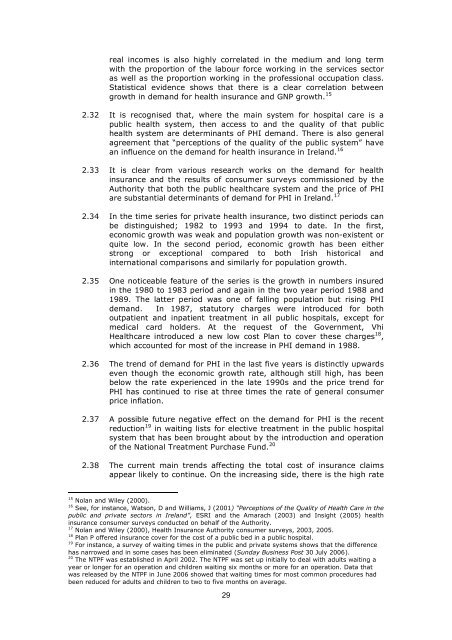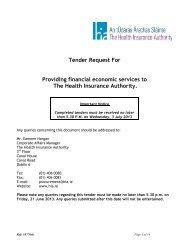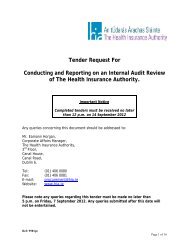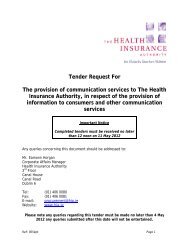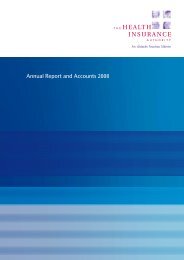Competition in the Irish Private Health Insurance Market
Competition in the Irish Private Health Insurance Market
Competition in the Irish Private Health Insurance Market
Create successful ePaper yourself
Turn your PDF publications into a flip-book with our unique Google optimized e-Paper software.
eal <strong>in</strong>comes is also highly correlated <strong>in</strong> <strong>the</strong> medium and long term<br />
with <strong>the</strong> proportion of <strong>the</strong> labour force work<strong>in</strong>g <strong>in</strong> <strong>the</strong> services sector<br />
as well as <strong>the</strong> proportion work<strong>in</strong>g <strong>in</strong> <strong>the</strong> professional occupation class.<br />
Statistical evidence shows that <strong>the</strong>re is a clear correlation between<br />
growth <strong>in</strong> demand for health <strong>in</strong>surance and GNP growth. 15<br />
2.32 It is recognised that, where <strong>the</strong> ma<strong>in</strong> system for hospital care is a<br />
public health system, <strong>the</strong>n access to and <strong>the</strong> quality of that public<br />
health system are determ<strong>in</strong>ants of PHI demand. There is also general<br />
agreement that “perceptions of <strong>the</strong> quality of <strong>the</strong> public system” have<br />
an <strong>in</strong>fluence on <strong>the</strong> demand for health <strong>in</strong>surance <strong>in</strong> Ireland. 16<br />
2.33 It is clear from various research works on <strong>the</strong> demand for health<br />
<strong>in</strong>surance and <strong>the</strong> results of consumer surveys commissioned by <strong>the</strong><br />
Authority that both <strong>the</strong> public healthcare system and <strong>the</strong> price of PHI<br />
are substantial determ<strong>in</strong>ants of demand for PHI <strong>in</strong> Ireland. 17<br />
2.34 In <strong>the</strong> time series for private health <strong>in</strong>surance, two dist<strong>in</strong>ct periods can<br />
be dist<strong>in</strong>guished; 1982 to 1993 and 1994 to date. In <strong>the</strong> first,<br />
economic growth was weak and population growth was non-existent or<br />
quite low. In <strong>the</strong> second period, economic growth has been ei<strong>the</strong>r<br />
strong or exceptional compared to both <strong>Irish</strong> historical and<br />
<strong>in</strong>ternational comparisons and similarly for population growth.<br />
2.35 One noticeable feature of <strong>the</strong> series is <strong>the</strong> growth <strong>in</strong> numbers <strong>in</strong>sured<br />
<strong>in</strong> <strong>the</strong> 1980 to 1983 period and aga<strong>in</strong> <strong>in</strong> <strong>the</strong> two year period 1988 and<br />
1989. The latter period was one of fall<strong>in</strong>g population but ris<strong>in</strong>g PHI<br />
demand. In 1987, statutory charges were <strong>in</strong>troduced for both<br />
outpatient and <strong>in</strong>patient treatment <strong>in</strong> all public hospitals, except for<br />
medical card holders. At <strong>the</strong> request of <strong>the</strong> Government, Vhi<br />
<strong>Health</strong>care <strong>in</strong>troduced a new low cost Plan to cover <strong>the</strong>se charges 18 ,<br />
which accounted for most of <strong>the</strong> <strong>in</strong>crease <strong>in</strong> PHI demand <strong>in</strong> 1988.<br />
2.36 The trend of demand for PHI <strong>in</strong> <strong>the</strong> last five years is dist<strong>in</strong>ctly upwards<br />
even though <strong>the</strong> economic growth rate, although still high, has been<br />
below <strong>the</strong> rate experienced <strong>in</strong> <strong>the</strong> late 1990s and <strong>the</strong> price trend for<br />
PHI has cont<strong>in</strong>ued to rise at three times <strong>the</strong> rate of general consumer<br />
price <strong>in</strong>flation.<br />
2.37 A possible future negative effect on <strong>the</strong> demand for PHI is <strong>the</strong> recent<br />
reduction 19 <strong>in</strong> wait<strong>in</strong>g lists for elective treatment <strong>in</strong> <strong>the</strong> public hospital<br />
system that has been brought about by <strong>the</strong> <strong>in</strong>troduction and operation<br />
of <strong>the</strong> National Treatment Purchase Fund. 20<br />
2.38 The current ma<strong>in</strong> trends affect<strong>in</strong>g <strong>the</strong> total cost of <strong>in</strong>surance claims<br />
appear likely to cont<strong>in</strong>ue. On <strong>the</strong> <strong>in</strong>creas<strong>in</strong>g side, <strong>the</strong>re is <strong>the</strong> high rate<br />
15 Nolan and Wiley (2000).<br />
16 See, for <strong>in</strong>stance, Watson, D and Williams, J (2001) “Perceptions of <strong>the</strong> Quality of <strong>Health</strong> Care <strong>in</strong> <strong>the</strong><br />
public and private sectors <strong>in</strong> Ireland”, ESRI and <strong>the</strong> Amarach (2003) and Insight (2005) health<br />
<strong>in</strong>surance consumer surveys conducted on behalf of <strong>the</strong> Authority.<br />
17 Nolan and Wiley (2000), <strong>Health</strong> <strong>Insurance</strong> Authority consumer surveys, 2003, 2005.<br />
18 Plan P offered <strong>in</strong>surance cover for <strong>the</strong> cost of a public bed <strong>in</strong> a public hospital.<br />
19 For <strong>in</strong>stance, a survey of wait<strong>in</strong>g times <strong>in</strong> <strong>the</strong> public and private systems shows that <strong>the</strong> difference<br />
has narrowed and <strong>in</strong> some cases has been elim<strong>in</strong>ated (Sunday Bus<strong>in</strong>ess Post 30 July 2006).<br />
20 The NTPF was established <strong>in</strong> April 2002. The NTPF was set up <strong>in</strong>itially to deal with adults wait<strong>in</strong>g a<br />
year or longer for an operation and children wait<strong>in</strong>g six months or more for an operation. Data that<br />
was released by <strong>the</strong> NTPF <strong>in</strong> June 2006 showed that wait<strong>in</strong>g times for most common procedures had<br />
been reduced for adults and children to two to five months on average.<br />
29


